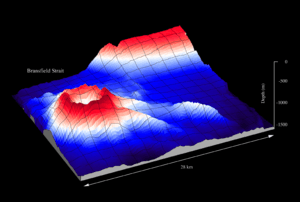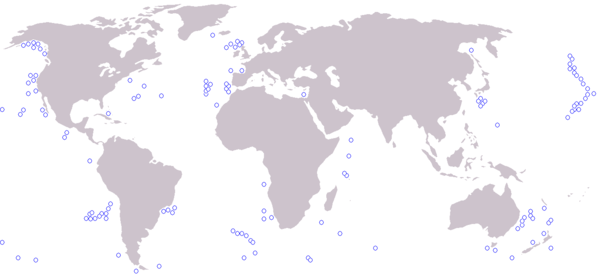Submarine volcano

1 Water vapor cloud
2 Water
3 Stratum
4 Lava flow
5 Magma conduit
6 Magma chamber
7 Dike
8 Pillow lava


Submarine volcanoes are underwater vents or fissures in the Earth's surface from which magma can erupt. They are estimated to account for 75% of annual magma output. The vast majority are located near areas of tectonic plate movement, known as ocean ridges. Although most are located in the depths of seas and oceans, some also exist in shallow water, which can spew material into the air during an eruption. Hydrothermal vents, sites of abundant biological activity, are commonly found near submarine volcanoes.
The presence of water can greatly alter the characteristics of a volcanic eruption and the explosions made by these. For instance, the increased thermal conductivity of water causes magma to cool and solidify much more quickly than in a terrestrial eruption, often turning it into a volcanic glass. Below ocean depths of about 2200 metres where the pressure exceeds 218 atmospheres, the critical pressure of water, it can no longer boil; it becomes a supercritical fluid. Without boiling sounds, deep-sea volcanoes are difficult to detect at great distances using hydrophones.
The lava formed by submarine volcanoes is quite different from terrestrial lava. Upon contact with water, a solid crust forms around the lava. Advancing lava flows into this crust, forming what is known as pillow lava.
Scientists still have much to learn about the location and activity of underwater volcanoes. The Kolumbo underwater volcano in the Aegean Sea was discovered in 1650 when it burst from the sea and erupted, killing 70 people on the nearby island of Santorini. More recently, NOAA's Office of Ocean Exploration has funded exploration of submarine volcanoes, with the Ring of Fire missions to the Mariana Arc in the Pacific Ocean being particularly noteworthy. Using Remote Operated Vehicles, scientists studied underwater eruptions, ponds of molten sulfur, black smoker chimneys and even marine life adapted to this deep, hot environment.
Many submarine volcanoes are seamounts, typically extinct volcanoes that rise abruptly from a seafloor of 1,000 - 4,000 meters depth. They are defined by oceanographers as independent features that rise to at least 1,000 meters above the seafloor. The peaks are often found hundreds to thousands of meters below the surface, and are therefore considered to be within the deep sea.[2] An estimated 30,000 seamounts occur across the globe, with only a few having been studied. However, some seamounts are also unusual. For example, while the summits of seamounts are normally hundreds of meters below sea level, the Bowie Seamount in Canada's Pacific waters rises from a depth of about 3,000 meters to within 24 meters of the sea surface.
-

Pillow lava formed by a submarine volcano
-

Spreading ridges volcanoes map
-

Map of world's major seamounts
-

Map of world's major hotspots
-

Lava from West Mata submarine volcano.
See also
References
- ↑ "Scientists Discover and Image Explosive Deep-Ocean Volcano". NOAA. 2009-12-17. Retrieved 2009-12-19.
- ↑ Nybakken, James W. and Bertness, Mark D., 2005. Marine Biology: An Ecological Approach. Sixth Edition. Benjamin Cummings, San Francisco
External links
| Wikimedia Commons has media related to Category:Submarine volcanoes. |
- Volcano Information from the Deep Ocean Exploration Institute, Woods Hole Oceanographic Institution
- Volcano World - now maintained by the Department of Geosciences at Oregon State University
- Britannica - Submarine Volcanoes
- United States Geological Survey
- Ring of Fire Exploration Mission
| |||||||||||||||||

